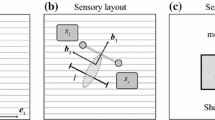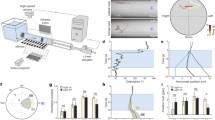Abstract
Many aquatic organisms detect the presence of moving objects in their environment, such as predators, by sensing the hydrodynamic disturbances the movements produce. The resultant water flow is readily detectable by stationary organisms, but free-swimming organisms are carried with the surrounding water and may not detect the bulk surrounding flow, which limits the available information about the source. We have developed a theory that clarifies what information is contained in disturbances generated by an attacking predator that is available to a free-swimming organism and might be extracted from local flow deformations alone. The theory shows that, depending on how well the deformations can be measured in space and time, an organism can reduce the range of possible locations, speeds, sizes, and arrival times of the predator. We apply the theory to planktonic copepods that have mechanosensory hairs along a pair of antennules. The study reveals the presence of “blind spots,” potential ambiguities in resolving from which of two sides a predator attacks, and whether it generates a bow wave or suction. Our findings lead to specific testable hypotheses concerning optimal escape strategies, which are helpful for interpreting the behavior of evasive prey and designing free-swimming robots with sensory capabilities.




Similar content being viewed by others
References
Acheson D (1990) Elementary fluid dynamics. Oxford University Press, Oxford
Ball E, Cowan A (1977) Ultrastructure of the antennal sensilla of Acetes (crustacea, decapoda, natantia, sergestidae). Philos Trans R Soc Lond B 277(957):429–457
Bleckmann H (2008) Peripheral and central processing of lateral line information. J Comp Physiol A 194(2):145–158
Bleckmann H, Breithaupt T, Blickhan R, Tautz J (1991) The time course and frequency content of hydrodynamic events caused by moving fish, frogs and crustaceans. J Comp Physiol 168:749–757
Breithaupt T, Tautz J (1990) The sensitivity of crayfish mechanoreceptors to hydrodynamic and acoustic stimuli. In: Wiese K, Krenz WD, Tautz J, Reichert H, Mulloney B (eds) Frontiers in crustacean neurobiology. Advances in life sciences. Birkhäuser, Basel, pp 114–120
Burdick D, Hartline D, Lenz P (2007) Escape strategies in co-occurring calanoid copepods. Limnol Oceanogr 52(6):2373–2385
Buskey E, Lenz P, Hartline D (2002) Escape behavior of planktonic copepods in response to hydrodynamic disturbances: high speed video analysis. Mar Ecol Prog Ser 235:135–146
Buskey E, Strickler J, Bradley C, Hartline D, Lenz P (2017) Escapes in copepods: comparison between myelinate and amyelinate species. J Exp Biol 220:754–758
Casas J, Dangles O (2010) Physical ecology of fluid flow sensing in arthropods. Annu Rev Entomol 55:505–520
Coombs S, Conley R (1997) Dipole source location in the mottled sculpin II. The role of lateral line excitation patterns. J Comp Physiol A 180:401–415
Ćurčić-Blake B, van Netten S (2006) Source location encoding in the fish lateral line canal. J Exp Biol 209(8):1548–1559
Devarakonda R, Barth F, Humphrey J (1996) Dynamics of arthropod filiform hairs. IV. Hair motion in air and water. Philos Trans R Soc Lond B 351:933–946
Gill C, Crisp D (1985) Sensitivity of intact and antennule amputated copepods to water disturbance. Mar Ecol Prog Ser 21:221–227
Goulet J, Engelmann J, Chagnaud B, Franosch J, Suttner M, Van Hemmen J (2008) Object localization through the lateral line system of fish: theory and experiment. J Comp Physiol A 194(1):1–17
Hanke W, Bleckmann H, Brucker C (2000) The ageing of the low-frequency water disturbances caused by swimming goldfish and its possible relevance to prey detection. J Exp Biol 203:1193–1200
Hartline D, Lenz P, Herren C (1996) Physiological and behavioral studies of escape responses in calanoid copepods. Mar Freshw Behav Physiol 27(2–3):199–212
Haury L, Kenyon D, Brooks J (1980) Experimental evaluation of the avoidance reaction of Calanus finmarchicus. J Plankton Res 2(3):187–202
Kasumyan A (2003) The lateral line in fish: structure, function, and role in behavior. J Ichthyol 43(2):S175–S213
Kiørboe T (2013) Predator and prey perception in copepods due to hydromechanical signals. Integr Comp Biol 53:821–831
Kiørboe T, Visser A (1999) Predator and prey perception in copepods due to hydromechanical signals. Mar Ecol Prog Ser 179:81–95
Kiørboe T, Saiz E, Visser A (1999) Hydrodynamic signal perception in the copepod Acartia tonsa. Mar Ecol Prog Ser 179:97–111
Lenz P, Hartline D (2014) Mechanoreception in crustaceans of the pelagic realm. In: Derby C, Thiel M (eds) Nervous systems and control of behavior, vol 3. Oxford University Press, Oxford, pp 293–320
Lenz P, Yen J (1993) Distal setal mechanoreceptors of the first antennae of marine copepods. Bull Mar Sci 53(1):170–179
Maxey MR, Riley JJ (1983) Equation of motion for a small rigid sphere in a nonuniform flow. Phys Fluids 26(4):883–889
Mellon D (2014) Sensory systems of crustaceans. In: Derby C, Thiel M (eds) Nervous systems and control of behavior, vol 3. Oxford University Press, Oxford, pp 49–84
Park T (1966) The biology of a calanoid copepod: Epilabidocera amphitrites McMurrich. Cellule 66:129–251
Stewart W, Nair A, Jiang H, McHenry M (2014) Prey fish escape by sensing the bow wave of a predator. J Exp Biol 217(24):4328–4336
Strickler J, Bal A (1973) Setae of the first antennae of the copepod Cyclops scutifer (Sars): their structure and importance. Proc Natl Acad Sci 70(9):2656–2659
Tao J, Yu X (2012) Hair flow sensors: from bio-inspiration to bio-mimicking? A review. Smart Mater Struct 21(11):113,001
Triantafyllou M, Weymouth G, Miao J (2016) Biomimetic survival hydrodynamics and flow sensing. Annu Rev Fluid Mech 48:1–24
vanDuren L, Stamhuis E, Videler J (1998) Reading the copepod personal ads: increasing encounter probability with hydromechanical signals. Philos Trans R Soc Lond B 353:691–700
Visser A (2001) Hydromechanical signals in the plankton. Mar Ecol Prog Ser 222:1–24
Vogel HD, Bleckmann (2000) Behavioral discrimination of water motions caused by moving objects. J Comp Physiol A 186:1107–1117
Weatherby T, Lenz P (2000) Mechanoreceptors in calanoid copepods: designed for high sensitivity. Arthropod Struct Dev 29(4):275–288
Wiese K (1974) The mechanoreceptive system of prey localization in Notonecta. II. The principle of prey localization. J Comp Physiol A 92:317–325
Wubbels R, Schellart N (1997) Neuronal encoding of sound direction in the auditory midbrain of the rainbow trout. J Neurophysiol 77(6):3060–3074
Yamaji I (1976) Illustrations of the marine plankton of Japan. Hoikusha, Osaka
Yen J, Lenz P, Gassie D, Hartline D (1992) Mechanoreception in marine copepods: electrophysiological studies on the first antennae. J Plankton Res 14(4):495–512
Yen J, Murphy D, Fan L, Webster D (2015) Sensory-motor systems of copepods involved in their escape from suction feeding. Integr Comp Biol 55:121–133
York C, Bartol I (2014) Lateral line analogue aids vision in successful predator evasion for the brief squid, Lolliguncula brevis. J Exp Biol 217(14):2437–2439
Young S, Dedwylder R, Friesen W (1981) Responses of the medicinal leech to water waves. J Comp Physiol A 144(1):111–116
Acknowledgements
We thank Drs. Petra Lenz and Ann Castelfranco for valuable discussions and critical reading of an earlier version of the manuscript.
Author information
Authors and Affiliations
Corresponding author
Additional information
We acknowledge support by US ARO Grant W911NF-15-1-0608 awarded from Dr. Virginia Pasour to DT and NSF Grants CBET-1603929 to DT and OCE-1235549 to P. Lenz.
Rights and permissions
About this article
Cite this article
Takagi, D., Hartline, D.K. Directional Hydrodynamic Sensing by Free-Swimming Organisms. Bull Math Biol 80, 215–227 (2018). https://doi.org/10.1007/s11538-017-0368-0
Received:
Accepted:
Published:
Issue Date:
DOI: https://doi.org/10.1007/s11538-017-0368-0




